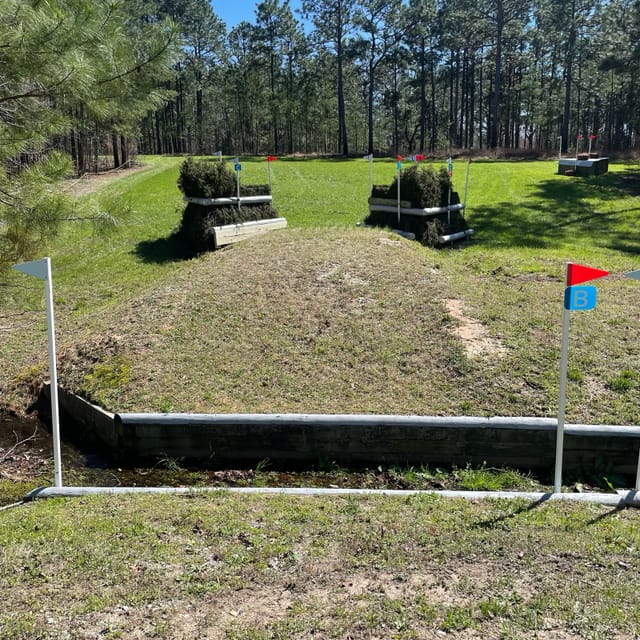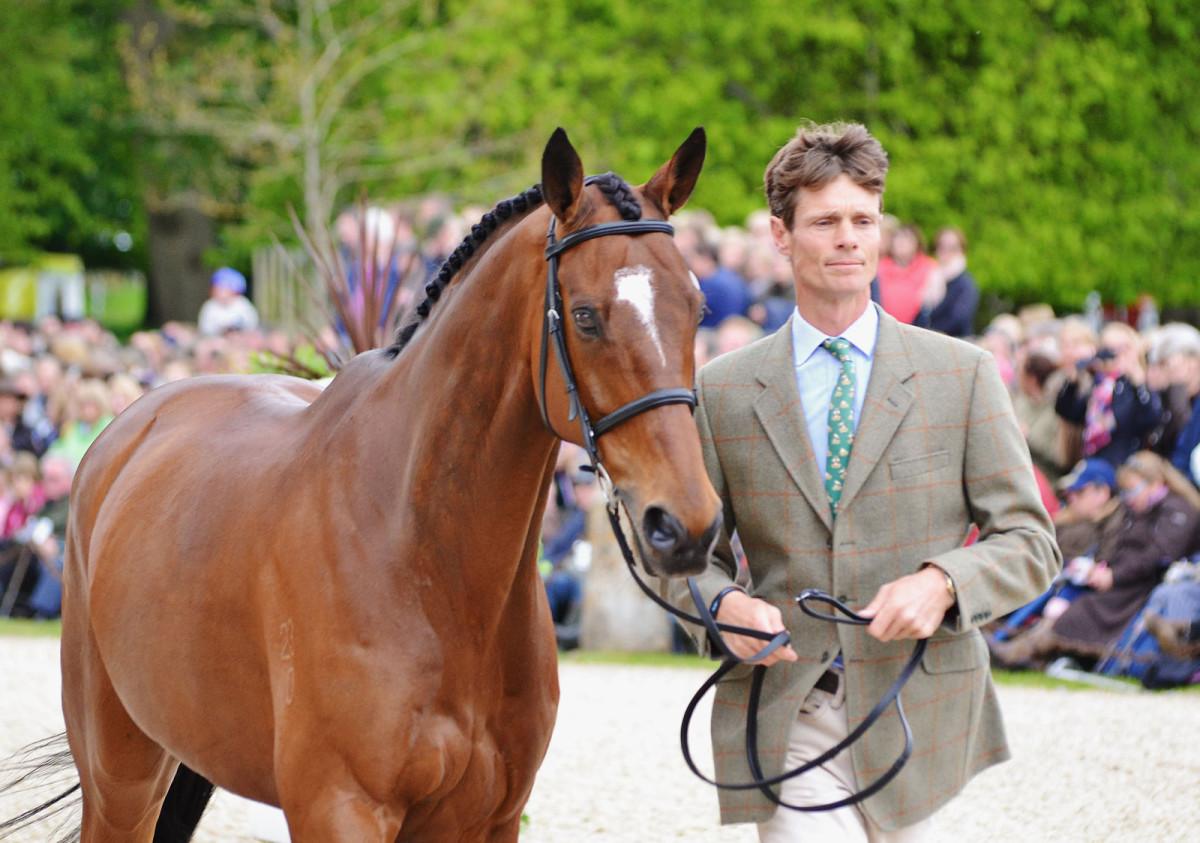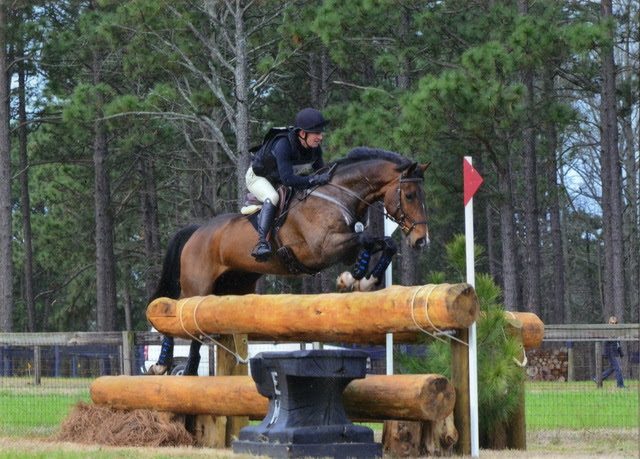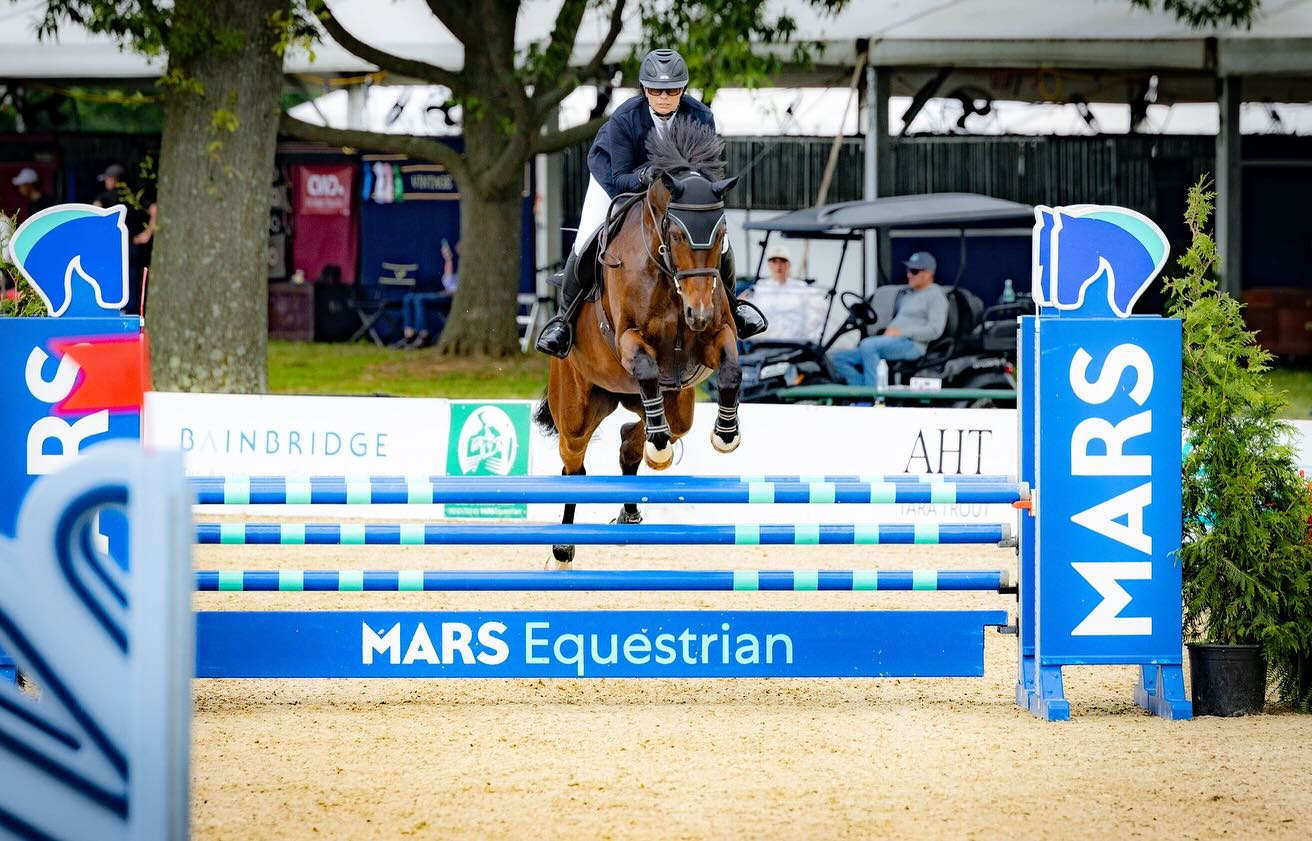
Tamie Smith and Mai Baum. Photo by Brant Gamma Photography.
As Tamie Smith and the Ahearn family’s Mai Baum (Loredano – Ramira, by Rike) came trotting from warm-up to competition ring this afternoon, one of the final pairs to see in the Setters’ Run CCI4*-S at Carolina International, other riders, judges, grooms, and spectators gathered around to watch the poetry in motion we’ve all come to anticipate.
“Harmony” is the word that has replaced the former collective marks on the dressage tests, both at National and FEI levels, and it’s what we see epitomized during a test like this. Riding in front of Peter Gray and Christina Klingspor, two members of this year’s FEI World Championships for Eventing, to be held in Italy this fall, Tamie and the 16-year-old “Lexus” danced and wove their way to a new record for this event: a 20.7 to shave just .10 off Kim Severson’s 2018 record with Cooley Cross Border.
“It’s awesome having [Mai Baum] as a long time partner,” Tamie said after her test. “Dressage is very enjoyable when I ride him now…he feels so strong this year and through and I’ve gotten better and he just feels amazing.”
Tamie has worked with highly sought-after coach Johann Hinnemann off and on for the last decade, but in the past few seasons has begun working with him on a more regular basis. Last year during her trip overseas, Tamie based with Johann for some additional help on the flat, and she says that mentorship has really helped her develop her partnerships further.
“Training with Jo has been game-changing,” Tamie said. “He’s a legend. My flatwork, my horses, and the feeling of them in their suppleness and throughness — I’ve learned so much. I learn almost more from just having conversations with him after our lessons and I feel grateful to have him part of my team.”
Tamie is basing with Will Faudree during her remaining time on the East coast before heading to Badminton with Mai Baum and has four of her other horses in tow while the rest of her team keeps the ship running back at home in southern California. Julianne Guariglia’s Solaguayre California (29.8 – 6th), Judith McSwain’s Fleeceworks Royal (32.0 – 12th), and the Elliot V Partnership’s Elliot V (25.7 – 18th) are all also competing in the 4*S this weekend.
“This would be their first time out at a big event,” Tamie said of her string to Frankie Thieriot-Stutes on the live broadcast. “Fleeceworks Royal hasn’t been out in a really atmosphere type event for a couple of years, she’s just been kind of running locally at home and I was traveling a lot so she didn’t get a lot of runs last year. The others are green — [Elliot V] is green, I was really proud of him in the ring and how he composed himself, and Solaguayre California is a super promising young horse who had some green mistakes, but she’s stunning. So we’re training and kind of assessing where they’re at and going to go from there. With Lexus, it’s just getting him in the ring — I wish you could’ve seen his warm-up because he was just so excited to be at an event. He always makes me a little bit nervous these days because he gets quite excited, but we’re here training even though we’re competing.”
As Tamie continues her prep for Badminton in May, she told Practical Horseman she does not plan to run Mai Baum cross country on Saturday.
You can watch Tamie and Mai Baum’s full test below, thanks to our friends at Horse & Country:
Watch Tamie Smith (Next Level Eventing) and Mai Baum break the Carolina International CCI and Horse Trial CCI4*-S dressage record with a 20.7 earned from judges Peter Gray and Christina Klingspor.
Full scores ▶️ https://evententries.com/#LiveScoreszDxH9bYVfZ$DK9E8OvrUGQ==
Horse & Country TV live stream: https://app.horseandcountry.tv/usea
Posted by Eventing Nation on Thursday, March 24, 2022
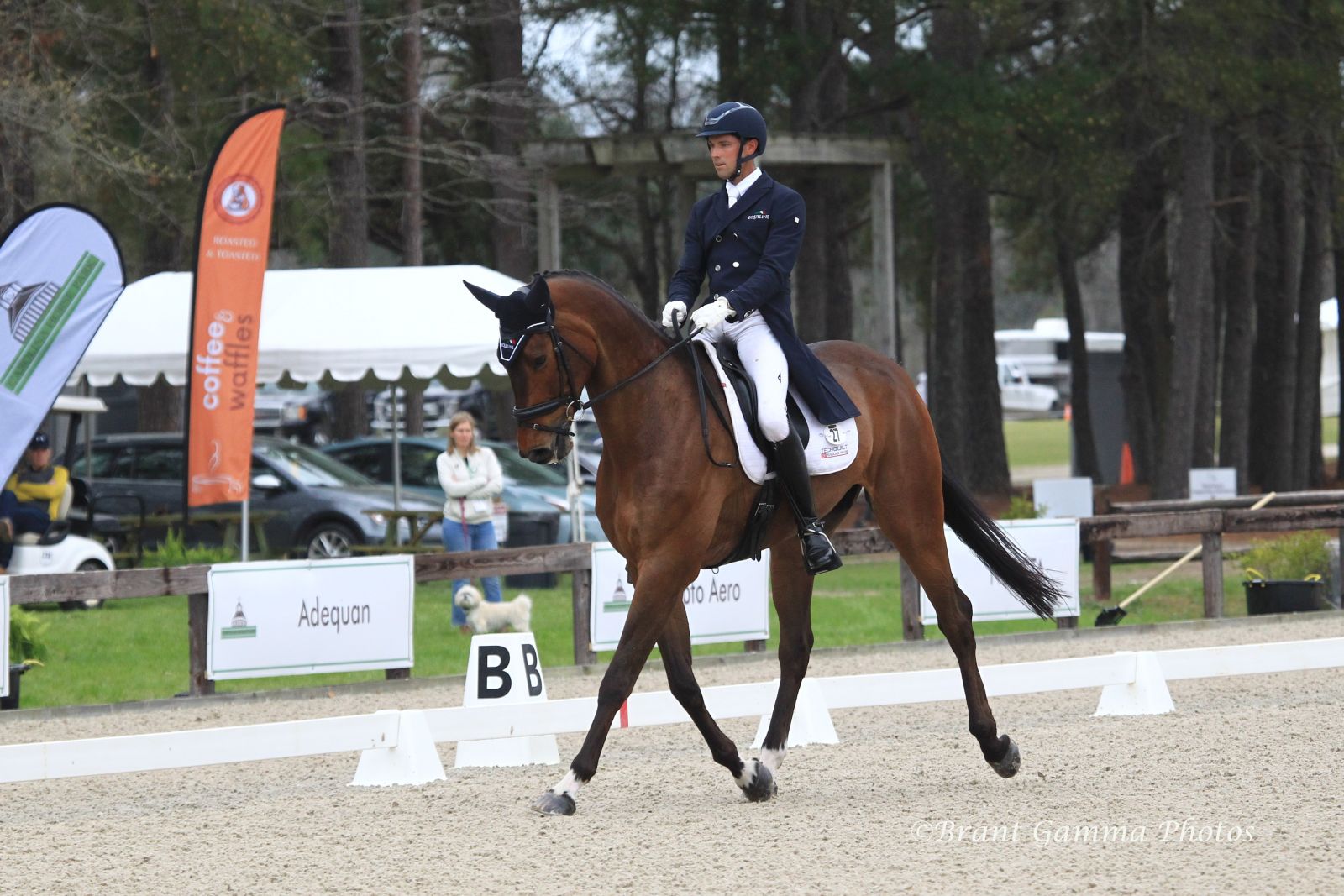
Will Coleman and Dondante. Photo by Brant Gamma Photography.
Will Coleman all but punched the air with satisfaction after a near-flawless ride aboard Team Rebecca LLC’s Dondante (Pachio – Muckno Clover, by Euro Clover), who earned a personal best at the level and improved on his previous lowest by 5.3 penalty points for a 27.4 and second place early on. The striking Irish Sport Horse gelding is 12 this year and looks to be in his finest form yet here on day one; this is a wonderful partnership to have watched develop since the horse’s Young Event Horse days, and even Will told The Chronicle in 2019 that Dondante wouldn’t necessarily blow anyone away on the flat — look at him now!
“I was really pleased with Dondante today,” Will commented. “He is feeling a little bit more established and confident and while there are always some areas we can clean up, he was great today. My team and I have been quietly confident that he was capable of getting some better marks and I am just thrilled for his owners, Team Rebecca and the Four Star Eventing Group who have been a part of his career from the start.”

Doug Payne and Starr Witness. Photo by Brant Gamma Photography.
Another busy rider in the 4*S this weekend is Doug Payne, whose 2019 Pan American Games partner Starr Witness (Chello II – Carmen, by Veneur) showed her growing strength and maturity in the ring to lay down a 28.7 that took the lead during the first half of the day. Starr Witness is owned by Laurie McRee and Catherine Winter.
“I’m privileged to have such a great group of horses here,” Doug commented after his test. “Starr Witness was excellent, it’s probably the best test she’s ever done to date.” He describes “the Ginja Ninja” as more on the careful side of the spectrum during the jumping phases, but he’ll have a couple of cracks around Ian Stark’s beefy track ahead of her time to figure out the best plan of attack.
Doug’s Tokyo Olympics partner, Debi Crowley’s Vandiver (Windfall – Visions of Grandeur, by Mystic Replica xx), also put in a solid effort to earn a 30.7 for eighth place overnight. Doug describes Vandiver as “not impressed by anything”, which means we’ll likely see him be the most efficient and quick with his experienced partner come Saturday.
Sydney Elliott, who rode earlier in the day, took the lead after her test with Carol Stephens’ QC Diamantaire (Diarado – Lantana, by Sandro Hit), scoring a 28.8 that would eventually be overtaken but still leave this pair tied for fourth overnight. This pair, who represented the U.S. on the silver medal-winning Nations Cup team that traveled to Boekelo in 2021, is headed for their second 5* start at Kentucky next month (they finished inside the top 20 during their first 5* start together in 2021).
“I was super thrilled with Q,” Sydney said. “This is our second outing of the year and we’re getting better so hopefully we continue to trend to Kentucky.”
Speaking on Carolina as a popular prep for Kentucky, Sydney agreed with the general sentiments. “It’s monumental, especially for fitness with our horses. We expect to go quite fast on Saturday and really open up his lungs and have a good run. Even though we have one more event with The Fork, this one will set the tone for Kentucky.”
Will Faudree impressed early on with a relaxed and workmanlike show from Jennifer Mosing and Sterling Silver Stables’ Pfun (Tadmus – Celerina, by Cento), who scored a 28.8 to tie with Sydney, who is also a member of the “sorority house” Will calls his home these last few weeks (I think “Sigma Tau Faudree” has a nice ring to it), for fourth. “He is just such a dude,” Will said of Pfun. “I’ve had him a really long time, we have a great partnership. This phase is not easy for him. He doesn’t have huge flamboyancy in his movement, but he’s very workmanlike.”
This is a home event for Will, whose Gavilan Farm and Cloud 11 are perennial supporters of Carolina International. “I’m a bit biased because it’s my home event,” he explained. “Carolina Horse Park has done [a lot of work] to ensure top, top footing and a really good track. Ian Stark has designed a really beautiful, tough track. It just is a track you can really attack, and it sets the horses up really well for their five-stars at the end of April.”
Bits & Bobs:
Ariel Grald is riding with plenty of grit this weekend after losing her front teeth and breaking her nose from a kick to the face in January. She’s a tough nut, that one, and she turned in a lovely test from the impressive-looking Forrest Gump 124 (Fuerst Hymphenburg – Amaterasu, by Amerigo Vespucci xx), earning a 31.4 to tie for ninth. Annie Eldridge’s 11-year-old Hanoverian, “Shrimp” as he’s known at home, is new to this level, having won the CCI3*L at Tryon last fall, and showed some real promise as he continues to develop his strength and understanding of the sport. “I’m so lucky to ride him!” Ariel said. “His nerves and the atmosphere got to him a bit today, but I’m really excited about his future.”
Tamie Smith isn’t the only West coast representative competing at Carolina this weekend. She’s joined by Washington-based Marc Grandia, who comes forward with the 12-year-old Holsteiner gelding Campari FFF (Camiros – Tanner, by Ariadus). This pair put in a lovely effort today and were rewarded with a personal 4* best 30.5 to sit in seventh overnight. Recently relocated to Ocala from Washington, Alina Patterson with the 11-year-old German Sport Horse Flashback (Fuerst Fugger – Queen of Joy, by Quaterback) are also competing here this weekend, earning a 34.5 to sit in 16th overnight.
We love to welcome riders back to the top levels after some time away and today we shout out Heather Gillette, who returns to the Advanced and 4* level this year with the big and handsome off-track Thoroughbred, Vincent Chase (Value Plus xx – Her Entourage xx, by Elusive Quality xx). Dressage wouldn’t be “Vinnie’s” favorite part of the job, but he’ll be keen to get out jumping as the weekend progresses. Heather last competed at this level with her former five-star partner, Our Questionnaire, in 2013.
Looking to the other FEI divisions running this weekend, your leaders are:
CCI3*-S: Caroline Martin and Redfield Champion (27.0)

Caroline Martin and Redfield Champion. Photo by Brant Gamma Photography.
“Redfield Champion is just phenomenal,” Caroline said. “Paul Hendrix sourced him two years ago and he has been brilliant ever since. To have a horse that really wants to come out and win every day is an incredible feeling and it was great to see all his talent reflected in the marks today. He is only eight and both Blake and King are seven having just stepped up to the level this year so to see them all sitting at the top of such a competitive division is so rewarding.”
CCI2*-S: Dom Schramm and Quadrocana (25.2)

Dom Schramm and Quadrocana. Photo by Brant Gamma Photography.
“I thought Quodrocana did a lovely test, and she deserved every mark she got,” Dom said. “She has always been a super nice horse on the flat but for one reason or another something has always popped up. I thought today everything really came together and she did her best test. I’m looking forward to the weekend ahead and jumping on the grass tomorrow as I have found it is good practice and exposure.”
CCI1*-S: Lily Dal Cin and FE Bobby Dazzler (26.4)
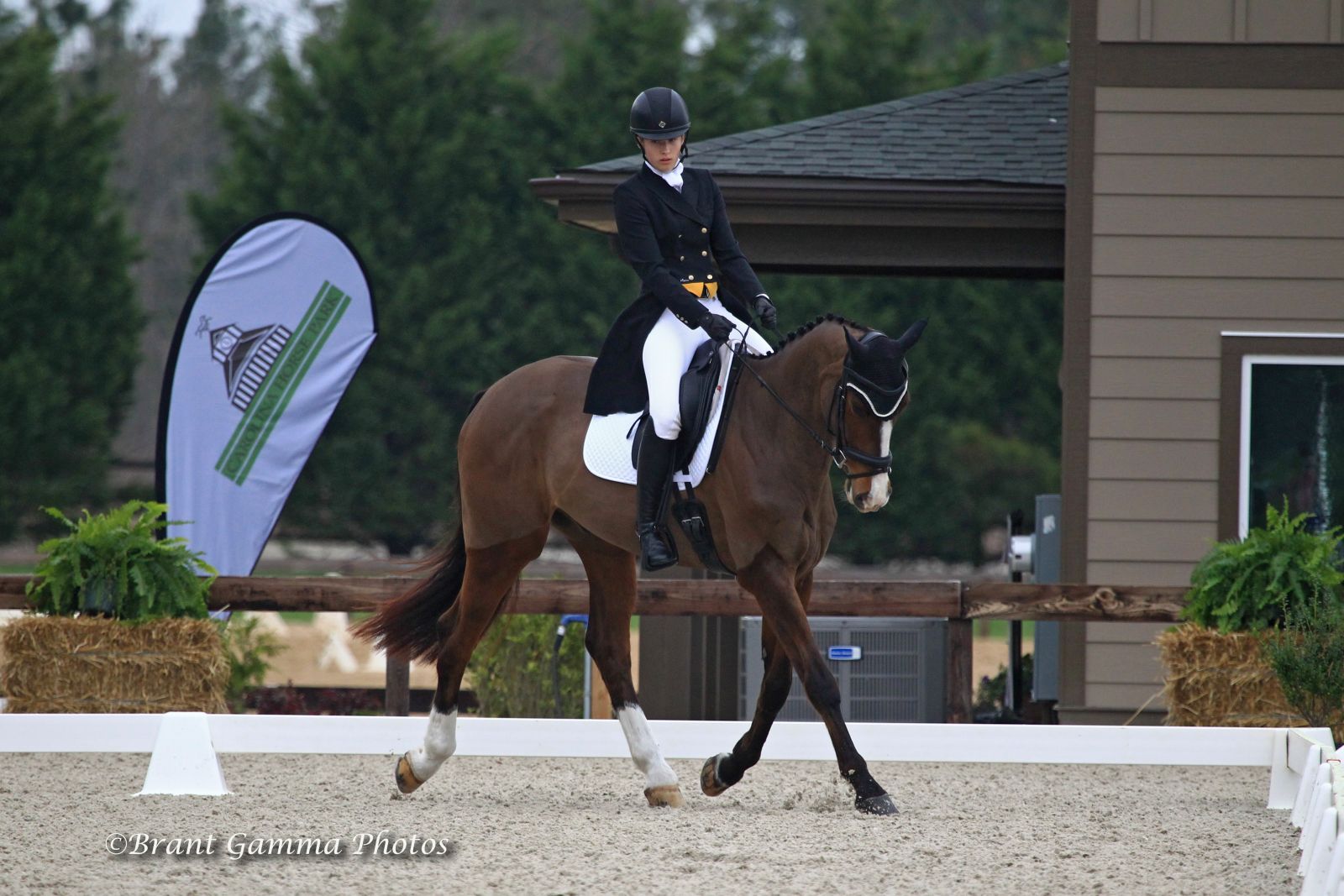
Lily Dal Cin and FE Bobby Dazzler. Photo courtesy of Brant Gamma Photography.
“FE Bobby Dazzler was super today, and I am just thrilled with him,” Lily said. “We had an amazing warm up and he was so relaxed going into the ring. He was obedient, and I was thinking he might have been a bit looky once he got into the ring, but he was so focused. This is both of our first FEI’s and he couldn’t have been better. I am really excited to be able to jump in the Derby Field tomorrow and I think the cross country course looks great.”
Next up, riders will take on Marc Donovan’s show jumping track tomorrow, followed by the cross country finale on Saturday. The schedule, updated as of yesterday, can be found here. Show jumping will begin at 10 a.m. ET with the CCI3*-S, followed by the CCI4*-S at 12:00 p.m. ET.
All jumping for the FEI divisions will stream on H&C+ this weekend. I highly recommend signing up for a subscription as H&C+ has a full roster of live streams coming up for 2022, on top of the masses of entertainment and educational content also available. Check out the USEA H&C+ hub here for more information. You can also sneak a peek at Ian Stark’s cross country course here on CrossCountryApp.
That does it for us after an exciting day one at Carolina! We’ll be back tomorrow with much more — thanks for following along, and as ever, Go Eventing.
This post may be updated with additional photos and quotes. Many thanks to Amanda Chance and Mikaela Kantorowski for their contributions to this report, as well as to official photographer Brant Gamma for providing media images.
Carolina International CCI & H.T. (Raeford, Nc.): [Website] [Entry Status] [Ride Times] [Live Scores] [Live Stream] [Volunteer] [Official Photographer]








